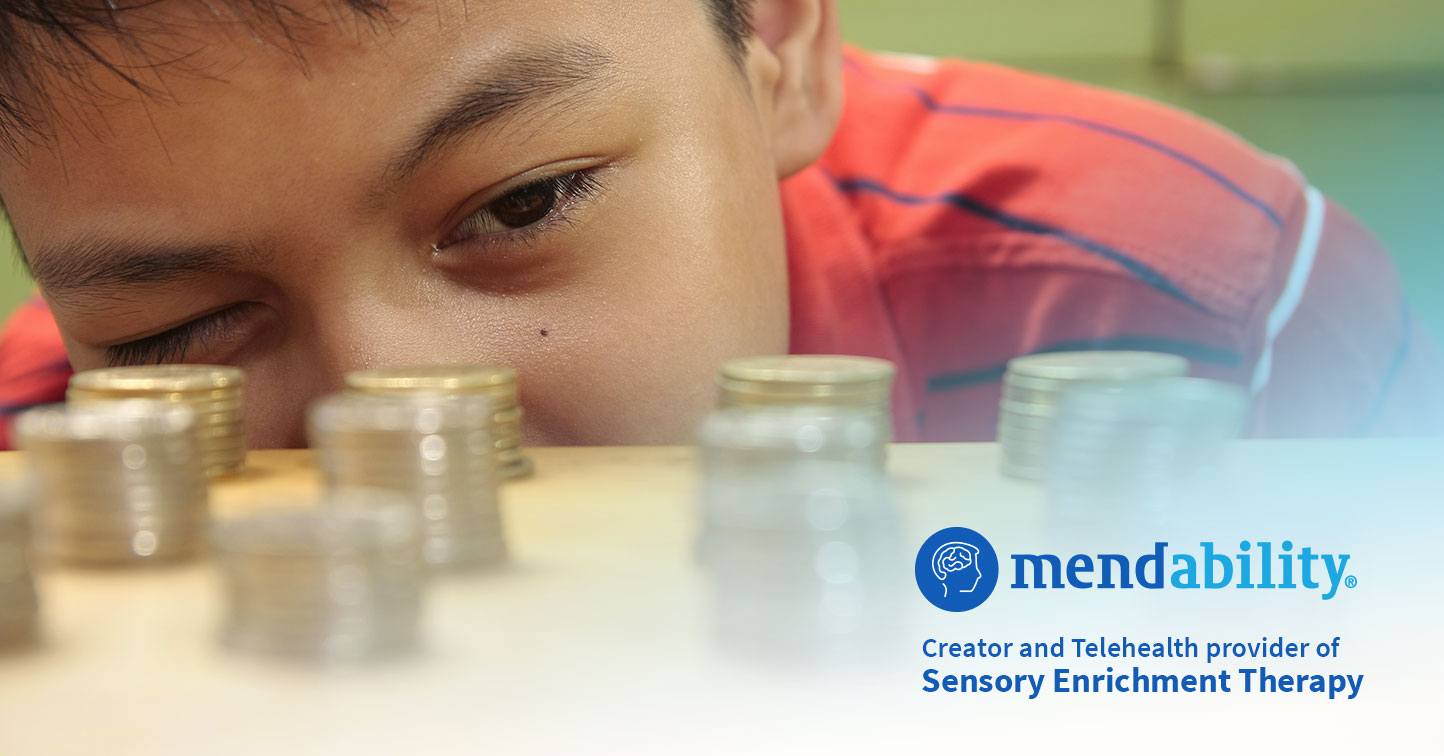What is stimming?
Stimming is an everyday term for self-stimulatory behavior and usually involves repetitive motions or sounds that are done in a regulated manner but do not appear to fulfill any visible purpose. We all stim occasionally. It is normal. Maybe you twirl your hair, tap your feet or crack your knuckles. The term ‘stimming,’ however, generally refers to the more intense and more frequent repetitive behaviors displayed by individuals with developmental disabilities, including autism.
For example, a child with autism may flap his hands, rock back and forth, spin objects, or pace around. He may also stim vocally (also called verbal or oral stims). These behaviors include mumbling to himself, spitting, groaning, screeching, and repeating the same phrase over and over. In some extreme situations, repetitive behaviors may lead to self-harm, such as when a person hits his or her head against a hard surface (referred to as head banging) or bites him or herself. People with autism may also perseverate or fixate on certain things like a light, a word, a texture or a video.
Stimming linked to anxiety
The familiar, repetitive motion of stimming can be soothing. Dr. Temple Grandin explains that she stimmed to calm herself.3 She notes,
“It may counteract an overwhelming sensory environment, or alleviate the high levels of internal anxiety these kids typically feel every day.”
Stimming can be a way of relieving pressure. Think of it like the steam valve of a pressure cooker that helps to maintain the optimum pressure inside by releasing some of the steam when necessary. If you hit your thumb with a hammer, do you shake it? The shaking motion helps distract you from the pain.
A 2012 study on the relationship between anxiety and repetitive behaviors in children with autism showed that those with higher levels of anxiety also displayed more stimming behaviors.2
Anxiety in autism linked to sensory processing
In many people with autism this anxiety is a result of their problems with sensory processing.4
Scientists have found that children with autism have low levels of brain serotonin.1 Serotonin is a brain chemical (neurotransmitter) that is involved in the processing of sensory messages, so low serotonin generally leads to sensory processing problems. When a person’s brain does not translate sensory information well, it results in anxiety.
It is not really surprising that individuals with autism live with a tremendous amount of anxiety when you consider that they may be experiencing an overload of sensory inputs at the same time as not having the communication skills to explain what they need or want. Stimming can help to relieve this anxiety.
For example, an autistic child may constantly jump up and down when he is watching a fun TV show. Even though the child likes the show, the images and sounds may still be causing sensory overload. Stimming is the child’s way to manage the sensory overload and enjoy the show.
Sensory Enrichment Therapy™ helps with sensory processing and reducing anxious buildup

Mendability helps families to do Sensory Enrichment Therapy, a new brain autism therapy, wherever they live, through an online portal and telehealth services.
References
- Chamberlain RS, Herman BH. A novel biochemical model linking dysfunctions in brain melatonin, proopiomelanocortin peptides, and serotonin in autism. 1990;28(9):773–793.
- Rodgers J, Glod M, Connolly B, McConachie H. The relationship between anxiety and repetitive behaviours in autism spectrum disorder. 2012;42(11):2404–2409.
- Why Do Kids with Autism Stim? – Autism Asperger’s Digest. 2011 Dec 27 [accessed 2016 Jan 18]. http://autismdigest.com/why-do-kids-with-autism-stim/
- Wigham S, Sarah W, Jacqui R, Mikle S, Helen M, Mark F. The Interplay Between Sensory Processing Abnormalities, Intolerance of Uncertainty, Anxiety and Restricted and Repetitive Behaviours in Autism Spectrum Disorder. 2014;45(4):943–952.
- Woo CC, Donnelly JH, Steinberg-Epstein R, Leon M. Environmental enrichment as a therapy for autism: A clinical trial replication and extension. 2015;129(4):412–422.
- Aronoff E, Hillyer R, Leon M. Environmental Enrichment Therapy for Autism: Outcomes with Increased Access. 2016
Is stimming and anxiety an area of concern for you or your loved one?
Sensory Enrichment Therapy™ helps develop resilience against stress, transitions and unexpected changes by boosting brain development in these areas.


 “It may counteract an overwhelming sensory environment, or alleviate the high levels of internal anxiety these kids typically feel every day.”
“It may counteract an overwhelming sensory environment, or alleviate the high levels of internal anxiety these kids typically feel every day.”
Hello, my 11 year old autistic son has been spitting everywhere sometimes when faced with an obvious (sometimes subtle) stressful situation. Also groans sometimes when anxious. He has also expressed other stimming behaviors such as poking his eye and bit himself one time when he was severely stressed from not having slept well for a while. His general behavior has also changed almost suddenly such as seeking out (can’t sleep alone is his room, always following his mother or older brother everywhere), he doesn’t want me around (the dad) and becomes agitated when he sees me. We were very close until 1 month ago when these changes started to manifest! Do you think he may be candidate for sensory enrichment therapy?
Hi Jon! What you describe sounds terrible, especially the part where your son doesn’t want you around any more. As I dad, this pricked my heart pretty hard. Sensory Enrichment can definitely help him feel more comfortable, yes. At the very least we can help his brain regulate its biochemistry a bit better, so that he has more “fuel” to cope with things around him and balance his mood. I suspect there are more issues than the anxious behavior you describe. You allude to sleep issues. Sleep is one of the first things to improve in almost all our clients. In fact, the top 5 areas where parents report the most progress in the first few weeks are sleep, eating, sensory processing, social skills and attention. Mood regulation comes later, but it makes sense when you understand that our program is designed to change the wiring in his brain, but to him, as he starts to process things differently, the world will appear to be changing and that will come with some added anxiety at first. We try our best to go slow when we need to, in order to help manage this side-effect of healing.
I have a granddaughter that is over 2 years old she doesn’t walk she scoots like a crab, she doesn’t talk she spits constantly it’s almost like she’s trying to talk to you but just spits and spits, she also just claps her hands and also with just yell out of the blue sometimes or starts laughing like crazy for no reason. We have done test after test and still no answers, any ideas? Could it possibly be autism?
Hello Nancy, it would be hard to comment on a diagnosis based on a quick email, but I would like to share a couple of thoughts that I hope will be useful in your journey.
1) Have you spoken to a developmental pediatrician about the possibility of Rhett’s syndrome?
2) For our program a formal diagnosis doesn’t matter as much. We can start a treatment plan based on a simple 300-question assessment and continue to tailor it based on the child’s progress every 2 weeks to boost brain development. In more complex situations (and Rhett’s would be one) and/or to address specific symptoms we would recommend that you work directly with our program director rather than our computer system.
If you would like to discuss this in more detail, feel free to set up a consultation. See if there is a time that works for you here: https://mendability.com/scheduling/free-consultation
Yes it is Autism
Hadn’t realised that my son’s dabbing was a form of stimming before. It’s hard to tell if he’s anxious or not because he also has ADHD.
Hello Emily, some symptoms are hard to categorize neatly, aren’t they? Is he anxious or impatient? Is it sensory overload or pain? Hungry or tired?
Anxiety is a feeling of uneasiness with the environment and/or circumstances whether the threat is real or perceived. Would you say his behavior is driven by fear?
Would this kind of therapy help with a 25 year old if not suggestions thanks
Yes, Fatima, Sensory Enrichment Therapy helps adults with autism as well. In studies, when they split the study population into age groups, the scientists saw that age does not seem to be a factor in the success of this treatment program. They adult group progressed at a rate very similar to they younger population. Because Sensory Enrichment Therapy works well with adults, have been working with more and more older individuals. They are doing really well.
Interesting